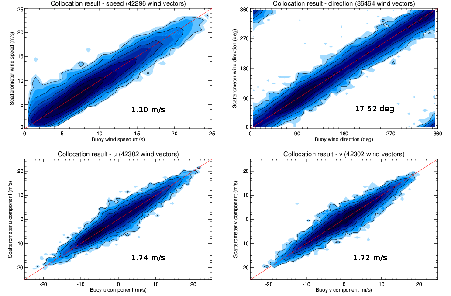| |
NSCAT-4 geophysical model function
The NSCAT-4 geophysical model function (GMF) improves the consistency of retrieved
Ku-band scatterometer winds with moored buoys, specially for winds above 15 m/s.
The NSCAT-4 GMF was derived from the NSCAT-2 GMF. Above 15 m/s, a linear scaling of
the wind speed was applied. Subsequently, 0.2 m/s was added to all wind speeds.
v NSCAT-4 = v NSCAT-2 + 0.2
; v <= 15 m/s
v NSCAT-4 = 2/3 * v NSCAT-2 + 5.2
; v > 15 m/s
So, a 8 m/s wind from NSCAT-2 corresponds to a 8.2 m/s NSCAT-4 wind and a 24 m/s wind
from NSCAT-2 corresponds to a 21.2 m/s NSCAT-4 wind retrieval.
The NSCAT-2 GMF lookup table was adapted in this way for all
combinations of incidence and azimuth angles. This ensures that the fit in
measurement space of the backscatter quadruplets to the GMF will not change
(i.e., the MLE distribution will not change), hence maintaining all other
retrieval qualities.

SeaWinds NSCAT-4 winds vs. buoy winds for
January to December 2008. The numbers in the wind speed, direction, zonal and
meridional wind panels, denote the standard deviation of difference between
SeaWinds and buoy winds (click to enlarge).
The high speed correction was obtained by comparing scatterometer wind speeds
with buoy and ECMWF winds. The scatterometer wind speed bias versus the average
scatterometer and reference wind speed, reference being buoy or ECMWF winds,
has been minimized. Using the NSCAT-4 GMF, it has been verified that a rather
flat bias is obtained, both for Oceansat-2 (OSCAT) and QuikSCAT (SeaWinds)
scatterometers.
Note that precise tuning of high speed winds is not easy. Due to the limited
amount of available data above 15 m/s, the errors in the buoy and ECMWF winds
are not very well known. Comparison to NOAA hurricane flight data is ongoing
within the International Ocean Vector Winds Science Team (IOVWST).
The NSCAT-2 Ku-band geophysical model function (GMF), was empirically derived
from NSCAT data and it is described in the paper by Wentz and Smith (see below).
Portabella compared in his thesis NSCAT-2 to the later developed GMF for
QuikSCAT/SeaWinds, QSCAT-1. He concluded that NSCAT-2 provides a less ambiguous
wind product than QSCAT-1 without decreasing the quality of the wind retrieval.
In other words, in comparison with QSCAT-1, NSCAT-2 is capable of removing a
significant amount of unrealistic ambiguous wind solutions. This is described
in Appendix C of Marcos Portabella's thesis. Consequently, the NSCAT-2 GMF was
used for deriving SeaWinds winds in the OSI SAF.
Evolution of the NSCAT-type GMFs has the great advantage that its physical
properties apply to all Ku-band scatterometers, irrespective of their different
incidence angles. The NSCAT, SeaWinds and OSCAT incidence angles are all different.
NSCAT-4 is used for consistent OSI SAF Ku-band climate data records, both in
wind and backscatter.
Download
Tables and Fortran 90 code (15 MB, use the "tar -xf"
command to unpack on Unix/Linux). The package contains binary tables for HH and VV polarization
in big endian and little endian. A simple Fortran 90 program is included that will read a
table and displays some of its data values as a function of wind speed, azimuth angle and
incidence angle.
References
Wentz, F. and D. Smith,
A model function for the ocean normalized radar cross section at 14 GHz derived from NSCAT observations
J. Geophys. Res., 1999, 104, C5, 11499-11514,
doi:10.1029/98JC02148.
Portabella, M.,
Wind field retrieval from satellite radar systems
Thesis: University of Barcelona, 2002, Barcelona, Spain, 207p.
Complete text (pdf: 3 MB)
Further information
Please contact the
KNMI scatterometer team.
| |
Near real time Wind Products
OSI SAF Wind Climate Data Records
Discontinued Wind Products
Software
R&D work
Projects
|
